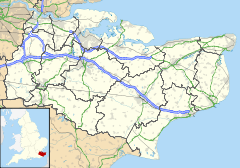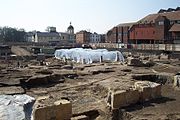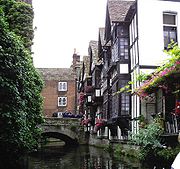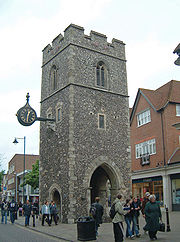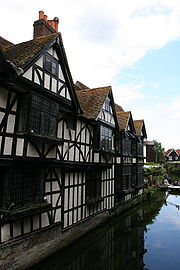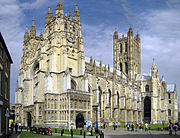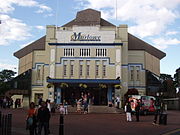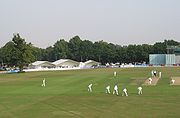
Canterbury
About this schools Wikipedia selection
This selection is made for schools by a children's charity read more. Sponsoring children helps children in the developing world to learn too.
Coordinates: 51.275°N 1.087°E
| Canterbury | |
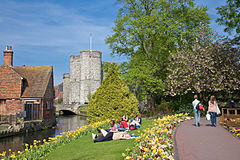 Canterbury lies on the Great Stour river |
|
|
|
|
| Population | 43,432 (2001) |
|---|---|
| OS grid reference | TR145575 |
| - London | 62.8 miles |
| District | Canterbury |
| Shire county | Kent |
| Region | South East |
| Country | England |
| Sovereign state | United Kingdom |
| Post town | CANTERBURY |
| Postcode district | CT1, CT2, CT3, CT4 |
| Dialling code | 01227 |
| Police | Kent |
| Fire | Kent |
| Ambulance | South East Coast |
| EU Parliament | South East England |
| UK Parliament | Canterbury |
|
|
Canterbury (pronounced /ˈkæntərbᵊri/ or /ˈkæntərbɛri/) is an English city which lies at the heart of the City of Canterbury, a district of Kent in South East England. It lies on the River Stour.
Originally a Brythonic settlement, it was renamed Durovernum Cantiacorum by the Roman conquerors in the 1st century AD. After it became the chief Jutish settlement, it gained its English name Canterbury, itself derived from the Old English Cantwareburh ("Kent people's stronghold"). After the Kingdom of Kent's conversion to Christianity in 597, St Augustine founded an episcopal see in the city and became the first Archbishop of Canterbury, a position that now heads the Church of England and the worldwide Anglican Communion (though the modern-day Province of Canterbury covers the entire south of England). Thomas Becket's murder at Canterbury Cathedral in 1170 led to the cathedral becoming a place of pilgrimage for Christians worldwide. This pilgrimage provided the theme for Geoffery Chaucer's 14th-century literary classic The Canterbury Tales. The literary heritage continued with the birth of the playwright Christopher Marlowe in the city in the 16th century.
Many historical structures remain in the city, including a city wall founded in Roman times and rebuilt in the 14th century, the ruins of St Augustine's Abbey and a Norman castle, and perhaps the oldest school in England, The King's School. Modern additions include the University of Kent, Canterbury Christ Church University, the Marlowe Theatre, and the St Lawrence Ground, home to Kent County Cricket Club. The city lies at the heart of the City of Canterbury, a local government district.
History
Early history
The Canterbury area has been inhabited since prehistoric times. Lower Paleolithic axes, and Neolithic and Bronze Age pots have been found in the area. Canterbury was first recorded as the main settlement of the Celtic tribe, the Cantiaci, which inhabited most of modern day Kent. In the 1st century AD, the Romans captured the settlement, and named it Durovernum Cantiacorum, meaning "stronghold of the Cantiaci by the alder grove". The Romans rebuilt the city, with new streets in a grid pattern, a theatre, a temple, a forum and public baths. In the late 3rd century, to defend against attack from barbarians, the Romans built around the city an earth bank and a wall with seven gates, which enclosed an area of 130 acres (53 ha).
After the Romans left Britain in 410 AD, Durovernum Cantiacorum was abandoned, apart from a few farmers, and gradually decayed. Over the next 100 years, an Anglo-Saxon community formed within the city walls, as Jutish refugees arrived, possibly intermarrying with the locals. The Jutes named the city Cantwaraburh, meaning "Kent people's stronghold". In 597 AD, Pope Gregory the Great sent Augustine to convert King Æthelberht of Kent to Christianity. After the conversion, Canterbury, as a Roman town, was chosen by Augustine as the centre for an episcopal see in Kent, and an abbey and cathedral were built. Augustine thus became the first Archbishop of Canterbury. The town's new importance led to its revival, and trades developed in pottery, textiles and leather. By 630, gold coins were being struck at the Canterbury mint. In 672 the Synod of Hertford gave the see of Canterbury authority over the entire English Church.
In 842 and 851, Canterbury suffered great loss of life during Danish raids. In 978, Archbishop Dunstan refounded the abbey built by Augustine, and named it St Augustine's Abbey. A second wave of Danish attacks began in 991, and in 1011 the cathedral was burnt and Archbishop Alphege was killed. Remembering the destruction caused by the Danes, the inhabitants of Canterbury did not resist William the Conqueror's invasion in 1066. William immediately ordered a wooden motte-and-bailey castle to be built by the Roman city wall. In the early 12th century, the castle was rebuilt with stone.
After the murder of Archbishop Thomas Becket at the cathedral in 1170, Canterbury became one of the most notable towns in Europe, as pilgrims from all parts of Christendom came to visit his shrine. This pilgrimage provided the framework for Geoffrey Chaucer's 14th-century collection of stories, The Canterbury Tales.
Canterbury is associated with several saints from this period who lived in Canterbury:
- Saint Augustine of Canterbury
- Saint Anselm of Canterbury
- Saint Thomas Becket
- Saint Mellitus
- Saint Theodore of Tarsus
- Saint Dunstan
- Saint Adrian of Canterbury
- Saint Alphege
- Saint Æthelberht of Kent
14th–17th centuries
The Black Death hit Canterbury in 1348. At 10,000, Canterbury had the 10th largest population in England; by the early 16th century, the population had fallen to 3,000. In 1363, during the Hundred Years' War, a Commission of Inquiry found that disrepair, stone-robbing and ditch-filling had led to the Roman wall becoming eroded. Between 1378 and 1402, the wall was virtually rebuilt, and new wall towers were added. In 1381, during the Peasants' Revolt, the castle and Archbishop's Palace were sacked, and Archbishop Sudbury was beheaded in London. Sudbury is still remembered annually by the Christmas mayoral procession to his tomb at Canterbury Cathedral. In 1413 Henry IV became the only sovereign to be buried at the cathedral. In 1448 Canterbury was granted a City Charter, which gave it a mayor and a high sheriff; the city still has a Lord Mayor and Sheriff. In 1504 the cathedral's main tower, the Bell Harry Tower, was completed, ending 400 years of building.
During the Dissolution of the Monasteries, the city's priory, nunnery and three friaries were closed. St Augustine's Abbey, the 14th richest in England at the time, was surrendered to the Crown, and its church and cloister were levelled. The rest of the abbey was dismantled over the next 15 years, although part of the site was converted to a palace. Thomas Becket's shrine in the Cathedral was demolished and all the gold, silver and jewels were removed to the Tower of London, and Becket's images, name and feasts were obliterated throughout the kingdom, ending the pilgrimages.
By the 17th century, Canterbury's population was 5,000; of whom 2,000 were French-speaking Protestant Huguenots, who had begun fleeing persecution and war in the Spanish Netherlands in the mid-16th century. The Huguenots introduced silk weaving into the city, which by 1676 had outstripped wool weaving.
In 1620 Robert Cushman negotiated the lease of the Mayflower at 59 Palace Street for the purpose of transporting the Pilgrims to America.
In 1647, during the English Civil War, riots broke out when Canterbury's puritan mayor banned church services on Christmas Day. The rioters' trial the following year led to a Kent revolt against the Parliamentarian forces, contributing to the start of the second phase of the war. However, Canterbury surrendered peacefully to the Parliamentarians after their victory at the Battle of Maidstone.
18th century–present
The city's first newspaper, the Kentish Post, was founded in 1717. It merged with the newly founded Kentish Gazette in 1768.
By 1770 the castle had come into disrepair, and many parts of it were demolished during the late 18th century and early 19th century. In 1787 all the gates in the city wall, except for Westgate - the city jail - were demolished as a result of a commission that found them impeding to new coach travel. By 1820 the city's silk industry had been killed by imported Indian muslins. The Canterbury and Whitstable Railway, the world's first passenger railway, was opened in 1830. Between 1830 and 1900, the city's population grew from 15,000 to 24,000. Canterbury Prison was opened in 1808 just outside the city limits.
During the First World War, a number of barracks and voluntary hospitals were set up around the city, and in 1917 a German bomber crash-landed near Broad Oak Road. During the Second World War, 10,445 bombs dropped during 135 separate raids destroyed 731 homes and 296 other buildings in the city, including the Simon Langton Grammar Schools, and 115 people were killed. The most devastating raid was on 1 June 1942 during the Baedecker Blitz.
Before the end of the war, architect Charles Holden drew up plans to redevelop the city centre, but locals were so opposed that the Citizens' Defence Association was formed and swept to power in the 1945 municipal elections. Post-war rebuilding of the city centre eventually began 10 years after the war. A ring-road was constructed outside the city walls some time after in stages to alleviate growing traffic problems in the city centre, which was later pedestrianised. The biggest expansion to the city occurred in the 1960s, with the arrival of the University of Kent at Canterbury and Christ Church College.
The 1980s saw visits from Pope John Paul II and Queen Elizabeth II, and the beginning of the annual Canterbury Festival. Canterbury received its own radio station in CTFM, now KMFM Canterbury, in 1997. Between 1999 and 2005, the Whitefriars shopping centre underwent major redevelopment. In 2000, during the redevelopment, a major archaeological project was undertaken by the Canterbury Archaeological Trust, known as the Big Dig, which was supported by Channel Four's Time Team.
Another famous visitor was Mahatma Gandhi, who came to the city in October 1931; on this occasion he met Hewlett Johnson, then Dean of Canterbury.
Governance
Since 1987, the Member of Parliament for the Canterbury constituency, which includes Whitstable, has been the Conservative Julian Brazier. At the 2005 general election, the Conservatives won a majority of 7,471 and 44.4% of the vote in the Canterbury constituency. Labour won 28.7% of the vote, Liberal Democrats 21.1%, the Green Party 3.2%, United Kingdom Independence Party 1.9%, and the Legalise Cannabis Alliance 0.7%.
Canterbury, along with Whitstable and Herne Bay, is in the City of Canterbury local government district. The city's urban area consists of the six electoral wards of Barton, Harbledown, Northgate, St Stephens, Westgate, and Wincheap. These wards have fifteen of the fifty seats on the Canterbury City Council. Twelve of these seats are held by the Liberal Democrats and three by the Conservatives.
The city became a county corporate in 1461, and later a county borough under the Local Government Act 1888. In 1974 it lost its status as the smallest county borough in England, after the Local Government Act 1972, and came under the control of Kent County Council.
Geography
Canterbury is located at 51°16′30″N 1°05′13″E (51.275, 1.087) in east Kent, about 55 miles (89 km) east-southeast of London. The coastal towns of Herne Bay and Whitstable are 6 miles (10 km) to the north, and Faversham is 8 miles (13 km) to the northwest. Nearby villages include Rough Common, Sturry and Tyler Hill. The civil parish of Thanington Without is to the southwest; the rest of the city is unparished. Harbledown, Wincheap and Hales Place are suburbs of the city.
The city is on the River Stour or Great Stour, flowing from its source at Lenham north-east through Ashford to the English Channel at Sandwich. The river divides south east of the city, one branch flowing though the city, the other around the position of the former walls. The two branches rejoin or are linked several times, but finally recombine around the town of Fordwich, on the edge of the marshland north east of the city. The Stour is navigable on the tidal section to Fordwich, although above this point canoes and other small craft can be used. Punts and rowed river boats are available for hire in Canterbury. The geology of the area consists mainly of brickearth overlying chalk. Tertiary sands overlain by London clay form St. Thomas's Hill and St. Stephen's Hill about a mile northwest of the city centre.
Demography
As of the 2001 UK census, the total population of the city's urban area wards was 43,432.
Residents of the city had an average age of 37.1 years, younger than the 40.2 average throughout the district and the 38.6 average for England. Of the 17,536 households, 35% were one-person households, 39% were couples, 10% were lone parents, and 15% other. Of those aged 16–74 in the city, 27% had a higher education qualification, higher than the 20% national average.
Compared with the rest of England, the city had an above-average proportion of foreign-born residents, at around 12%. Ninety-five percent of residents were recorded as white; the largest minority group was recorded as Asian, at 1.8% of the population. Religion was recorded as 68.2% Christian, 1.1% Muslim, 0.5% Buddhist, 0.8% Hindu, 0.2% Jewish, and 0.1% Sikh. The rest either had no religion, an alternative religion, or did not state their religion.
| Population growth in Canterbury since 1901 | ||||||||||||||||||
|---|---|---|---|---|---|---|---|---|---|---|---|---|---|---|---|---|---|---|
| Year | 1901 | 1911 | 1921 | 1931 | 1939 | 1951 | 1961 | 1971 | 2001 | |||||||||
| Population | 24,899 | 24,626 | 23,737 | 24,446 | 26,999 | 27,795 | 30,415 | 33,155 | 43,432 | |||||||||
| Source: A Vision of Britain through Time | ||||||||||||||||||
Economy
Canterbury district retains approximately 4,761 businesses, up to 60,000 full- and part-time employees and was worth £1.3 billion in 2001. This makes the district the second largest economy in Kent. Unemployment in the city has dropped significantly since 2001 owing to the opening of the Whitefriars shopping complex which introduced thousands of job opportunities. In April 2008, the Archbishop of Canterbury, Dr. Rowan Williams, controversially demanded that salary caps should be implemented to curb the pay of the rich in an attempt to manage to growth of the economy. The city's economy benefits mainly from significant economic projects such as the Canterbury Enterprise Hub, Lakesview International Business Park and the Whitefriars retail development. Tourism contributes £258M to the Canterbury economy and has been a "cornerstone of the local economy" for a number of years; Canterbury Cathedral alone generates over one million visitors a year.
Culture
Landmarks
Canterbury Cathedral is the Mother Church of the Anglican Communion and seat of the Archbishop of Canterbury. Founded in 597 AD by Augustine, it forms a World Heritage Site, along with the Saxon St. Martin's Church and the ruins of St Augustine's Abbey. With one million visitors per year, it is one of the most visited places in the country. Services are held at the Cathedral three or more times a day.
The Roman Museum houses an in situ mosaic pavement dating from around 300 CE. Surviving structures from the Roman times include Queningate, a blocked gate in the city wall, and the Dane John Mound, once part of a Roman cemetery. The Dane John Gardens were built beside the mound in the 18th century, and a memorial was placed on the mound's summit. A windmill was on the mound between 1731 and 1839.
The ruins of the Norman Canterbury Castle and St Augustine's Abbey are both open to the public. The medieval St Margaret's Church now houses the "The Canterbury Tales", in which life-sized character models reconstruct Geoffrey Chaucer's stories. The Westgate is now a museum relating to its history as a jail. The medieval church of St Alphege became redundant in 1982 but had a new lease of life as the Canterbury Urban Studies Centre, later renamed the Canterbury Environment Centre; the building is used by the King's School. The Old Synagogue at Canterbury, now the King's School Music Room, is one of only two Egyptian Revival synagogues still standing. The city centre contains many timber-framed 16th- and 17th -century houses, including the "Old Weaver's House" used by the Huguenots. St Martin's Mill is the only surviving mill out of the six known to have stood in Canterbury. It was built in 1817 and worked until 1890; it is now a house conversion.
The Museum of Canterbury, houses many exhibits, with one of them being the Rupert Bear Museum. The Herne Bay Times has reported that the Heritage at Risk Register includes 19 listed buildings in Canterbury which need urgent repair but for which the council has insufficient funds.
Theatres
The city's theatre and concert hall is the Marlowe Theatre named after Christopher Marlowe who was born in the city in Elizabethan times. He was baptised in the city's St George's Church, which was destroyed during the Second World War. The old Marlowe Theatre was located in St Margaret's Street and housed a repertory theatre. Another theatre – The Gulbenkian Theatre – also serves the city and can be found at the University of Kent. The Marlowe is currently being rebuilt on its former site.
Besides the two theatres, theatrical performances take place at several areas of the city, for instance the Cathedral and St Augustine's Abbey. The premiere of Murder in the Cathedral by T. S. Eliot took place at Canterbury Cathedral.
The oldest surviving Tudor theatre in Canterbury is now Casey's Bar, formerly known as The Shakespeare Pub. There are several theatre groups based in Canterbury, including the University of Kent Students' Union's T24 Drama Society, The Canterbury Players and Kent Youth Theatre.
The Marlowe Theatre
The redeveloped Marlowe Theatre will become the largest theatre in the region, offering touring productions and concerts. The programme will include musicals, drama, ballet, contemporary dance, classical orchestras, opera, children's shows, pantomime, stand-up comedy and concerts. There will also be a second performance space called The Marlowe Studio, dedicated to creative activity and the programming of new work. This theatre will also offer three bars with views of the city, a restaurant and a riverside terrace. It will re-open to audiences in October 2011, with tickets on-sale from March 2011.
Music
The Cathedral
Medieval
Polyphonic music written for the monks of Christ Church Priory (the Cathedral) survives from the 13th century. The Cathedral may have had an organ as early as the 12th century, though the names of organists are only recorded from the early 15th century. One of the earliest named composers associated with Canterbury Cathedral was Leonel Power, who was appointed master of the new Lady Chapel choir formed in 1438.
Post-Reformation
The Reformation brought a period of decline in the Cathedral's music which was revived under Dean Thomas Neville in the early 17th century. Neville introduced instrumentalists into the Cathedral's music who played cornett and sackbut, probably members of the city's band of waits. The Cathedral acquired sets of recorders, lutes and viols for the use of the choir boys and lay-clerks.
The City
Early modern
As was common in English cities in the Middle Ages, Canterbury employed a town band known as the Waits. There are records of payments to the Waits starting from 1402, though they probably existed earlier than this. The Waits were disbanded by the city authorities in 1641 for 'misdemeanors' but were reinstated in 1660 when they played for the visit of King Charles II on his return from exile. Waits were eventually abolished nationally by the Municipal Corporations Act of 1835. A modern early music group called The Canterbury Waits has revived the name.
The Canterbury Catch Club was a musical and social club which met in the city between 1779 and 1865. The club (male only) met weekly in the winter. It employed an orchestra to assist in performances in the first half of the evening. After the interval, the members sang catches and glees from the club's extensive music library (now deposited at the Cathedral Archives in Canterbury).
Contemporary
The city gave its name to a musical genre known as the Canterbury Sound or Canterbury Scene, a group of progressive rock, avant-garde and jazz musicians established within the city during the late 1960s and early 1970s. Some very notable Canterbury bands were Soft Machine, Caravan, Matching Mole, Egg, Hatfield and the North, National Health, Gilgamesh, Soft Heap, Khan, Camel and In Cahoots. Over the years, with band membership changes and new bands evolving, the term has been used to describe a musical style or subgenre, rather than a regional group of musicians.
The University of Kent has hosted concerts by bands including Led Zeppelin and The Who. During the late seventies and early eighties the Canterbury Odeon hosted a number of major acts, including The Cure and Joy Division. The Marlowe Theatre is also used for many musical performances, such as Don McLean in 2007, and Fairport Convention in 2008. A regular music and dance venue is the Westgate Hall.
The Canterbury Choral Society gives regular concerts in Canterbury Cathedral, specialising in the large-scale choral works of the classical repertory. The Canterbury Orchestra, founded in 1953, is a thriving group of enthusiastic players who regularly tackle major works from the symphonic repertoire. Other musical groups include the Canterbury Singers (also founded in 1953), Cantemus, and the City of Canterbury Chamber Choir. The University of Kent has a Symphony Orchestra, a University Choir, a Chamber Choir, and a University Concert Band and Big Band.
The Canterbury Festival takes place over two weeks in October each year in Canterbury and the surrounding towns. It includes a wide range of musical events ranging from opera and symphony concerts to world music, jazz, folk, etc., with a Festival Club, a Fringe, and Umbrella events. Canterbury also hosts the annual Lounge On The Farm festival in July, which mainly sees performances from rock, indie and dance artists.
The Reggae/Ska musician Judge Dread played his last gig at the Penny Theatre. His final words were "Let's hear it for the band." He then went offstage, and suffered a major Heart Attack, which despite help from both ambulance crews and the audience he died from.
Composers
Composers with an association with Canterbury include
- Thomas Tallis (c. 1505–1585), became a lay clerk (singing man) at Canterbury Cathedral c. 1540 and was subsequently appointed a Gentleman of the Chapel Royal in 1543.
- John Ward (1571–1638), born in Canterbury, a chorister at Canterbury Cathedral, composed madrigals, works for viol consort, services, and anthems.
- Orlando Gibbons (1583–1625), organist, composer, and Gentleman of the Chapel Royal, who died in Canterbury and was buried in the Cathedral.
- William Flackton (1709–1798), born in Canterbury, a chorister at Canterbury Cathedral, was an organist, viola player and composer.
- John Marsh (1752–1828), lawyer, amateur composer and concert organiser, wrote two symphonies for the Canterbury Orchestra before moving to Chichester in 1784.
- Thomas Clark (1775–1859), shoemaker and organist at the Methodist church in Canterbury, composer of ' West Gallery' hymns and psalm tunes.
- Sir George Job Elvey (1816–1893), organist and composer, was born in Canterbury and trained as a chorister at the Cathedral.
- Alan Ridout (1934–1996) educator and broadcaster, composer of church, orchestral and chamber music.
- Sir Peter Maxwell Davies was appointed an Honorary Fellow of Canterbury Christ Church University at a ceremony in Canterbury Cathedral.
- Many Canterbury Cathedral organists composed services, anthems, hymns, etc.
Sport
St Lawrence Ground is notable as one of the two grounds used regularly for first-class cricket that have a tree within the boundary (the other is the City Oval in Pietermaritzburg, South Africa). It is the home ground of Kent County Cricket Club and has hosted several One Day Internationals, including one England match during the 1999 Cricket World Cup.
Canterbury City F.C. reformed in 2007 as a community interest company and the mens team competed in the Kent County League Division Two (East) in 2007/08. The previous incarnation of the club folded in 2001. Canterbury's Rugby Football Club were founded in 1926 and became the first East Kent club to achieve National League status when they were promoted to the National League Division 3 South in 2006.
The Tour de France has visited the city twice. In 1994 the tour passed through, and in 2007 it held the finish for Stage 1. Canterbury Hockey Club is one of the largest clubs in the country, often succeeding to top the English leagues in all age and sex categories. Former Olympic gold medal winner Sean Kerly is one of their coaches.
Sporting activities for the public are provided at the Kingsmead Leisure Centre, which has a 33-metre (108 ft) swimming pool and a sports hall for football, basketball, and badminton.
Transport
Railway
Canterbury was the terminus of the Canterbury and Whitstable Railway (known locally as the Crab and Winkle line) which was a pioneer line, opened on 3 May 1830, and finally closed in 1953. Despite claims by the Stockton and Darlington Railway, the Canterbury and Whitstable was the first regular passenger steam railway in the world. The first station in Canterbury was at North Lane.
Today, Canterbury has two railway stations, Canterbury West and Canterbury East, both operated by Southeastern. Canterbury West station, on the South Eastern Railway from Ashford, was opened on 6 February 1846, and on 13 April the line to Ramsgate was completed. Canterbury West is served primarily from London Charing Cross with limited services from Victoria as well as by trains to Ramsgate and Margate. Canterbury East, the more central of the two stations, was opened by the London, Chatham and Dover Railway on 9 July 1860. Services from London Victoria stop at Canterbury East (journey time around 88 minutes) and continue to Dover. A fourth station in Canterbury was Canterbury South on the Elham Valley Railway, which opened in 1890 and closed in 1947. A high-speed train service to London St Pancras via Ashford International started on 13 December 2009. The journey time to London has been reduced to one hour.
Road
Canterbury is by-passed by the A2 London to Dover Road. It is about 45 miles (72 km) from the M25 London orbital motorway, and 61 miles (98 km) from central London. The other main road through Canterbury is the A28 from Ashford to Ramsgate and Margate. The City Council has invested heavily in Park-and-Ride systems around the City's outskirts and there are three sites: at Wincheap, New Dover Road and Sturry Road. There are plans to build direct access sliproads to and from the London directions of the A2 where it meets the congested Wincheap (at present there are only slips from the A28 to and from the direction of Dover) to allow more direct access to Canterbury from the A2, but these are currently subject to local discussion. The hourly National Express coach service to and from Victoria Coach Station (007), which leaves from the main bus station, is typically scheduled to take two hours.
Education
The city has many students as it is home to three universities, together with several other higher education institutions and colleges; at the 2001 census, 22% of the population aged 16–74 were full-time students, compared with 7% throughout England.
The city is host to four universities: The University of Kent, Canterbury Christ Church University, the University College for the Creative Arts and most recently GAU (The Girne American University).
The University of Kent's main campus is situated over 300 acres (121 ha) on St. Stephen's Hill, a mile north of Canterbury city centre. Formerly called the University of Kent at Canterbury, it was founded in 1965, with a smaller campus opened in 2000 in the town of Chatham. As of 2007, it had around 16,000 students.
Canterbury Christ Church University was founded as a teacher training college in 1962 by the Church of England. In 1978 its range of courses began to expand into other subjects, and in 1995 it was given the power to become a University college. In 2005 it was granted full university status, and as of 2007 it had around 15,000 students.
The University College for the Creative Arts is the oldest higher education institution in the city, having been founded in 1882 by Thomas Sidney Cooper as the Sidney Cooper School of Art. Near the University of Kent is the Franciscan International Study Centre, a place of study for the worldwide Franciscan Order. Chaucer College is an independent college for Japanese and other students within the campus of the University of Kent. Canterbury College, formerly Canterbury College of Technology, offers a mixture of vocation, further and higher education courses for school leavers and adults.
Independent secondary schools include Kent College, St Edmund's School and, what is often described as the oldest school in England, The King's School. St. Augustine established a school shortly after his arrival in Canterbury in 597, and it is from this that some claim The King’s School grew. Although, the documented history of the school only began after the Dissolution of the Monasteries in the 16th century, when the school acquired its present name, referring to Henry VIII.
The city's secondary grammar schools are Barton Court Grammar School, Simon Langton Grammar School for Boys and Simon Langton Girls' Grammar School; all of which in 2008 had over 93% of their pupils gain five or more GCSEs at grades A* to C, including English and maths. The non-selective state secondary schools are The Canterbury High School, St Anselm's Catholic School, the Church of England's Archbishop's School, and Chaucer Technology School; all of which in 2008 had more than 30% of their pupils gain five or more GCSEs at grades A* to C including English and maths.
International relations
Canterbury is twinned with the following cities:
City to City Partnership
 Esztergom, Hungary
Esztergom, Hungary
Protocol D'accord
